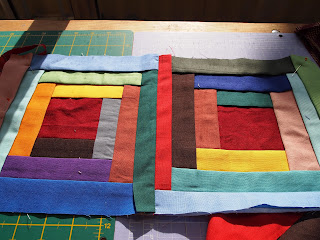Just Like Grandma Used to Make
 |
| Fully constructed blocks that are joined together |
I always find it interesting when I see a well known quilter demonstrate a quilting technique as something remarkably different and newly reintroduced that I've had knowledge of for a long time. Just recently I came across this when a method of constructing a log cabin was taught on a well known quilt show by a widely known published quilter. The quilter explained that through her research she discovered this technique pre-dates the earliest known American quilt called a log cabin and is a block recognized as one called tile roof in Great Britain. I'm not doubting this quilter did discover this in her research. Its just that I've known about it since I was a kid as it was taught to me by my grandmother - who wasn't British. How she learned it I don't know but I can only assume it was taught to her by her mother and so on. As it's something I learned so long ago I never gave it a second thought really. Too bad I didn't start teaching it to my quilting associates as a long lost technique.
Since seeing the show I decided to make the log cabin quilt that my grandmother taught me as a child just to see if it's the same as was presented on the quilting show. As I'm constructing it I believe it is the same technique. Who would have thought something old is something new?
For those of you interested in this it's a method of constructing a log cabin block that is essentially a quilt-as-you-go. It has no batting because as my grandmother explained to me, it is meant to be a summer quilt.
 |
| The strips are attached directly on top of the backing so the stitching is visible on the back as well. |
 |
| Strips are folded over once stitched so the stitching is not visible from the front, only the back. |
 |
| The folds give this gives the block itself a textured look. |
 |
| This is the blocks back. You can see my stitches here that make a decorative pattern on the back but aren't seen on the front. |
As the blocks are completed they're attached to each other in the usual quilt-as-you-go fashion. It's a great way to make a completely hand constructed quilt quickly as the block construction and quilting are done at the same time. Once you've finished making blocks, you've essentially finished quilting the quilt.
I'm making this one from left over solid scraps of other projects. Once all my blocks are complete I'll connect them and probably add a border and then its done. I'm glad I saw the television quilter refresh my memory on this technique. It's been so long since I used it, it may well have stayed forgotten had I not been reminded. I think my grandmother would be in complete awe of how much knowledge she possessed that quilters today are seeking out. I'm so happy to have learned even a small amount of this from her in my lifetime. Tonight I'm meeting with the Perth Modern Quilters and I'm going to bring along this project to show and tell. I'd like to pass along the knowledge I have to them and in doing so a little bit of my grandmother goes on. That's the beauty of quilting to me. It's being able to continue the long chain of acquired experience that came before me and hopefully will go on after me.




Even more amazing IRL
ReplyDeleteThank you Laura.
ReplyDelete